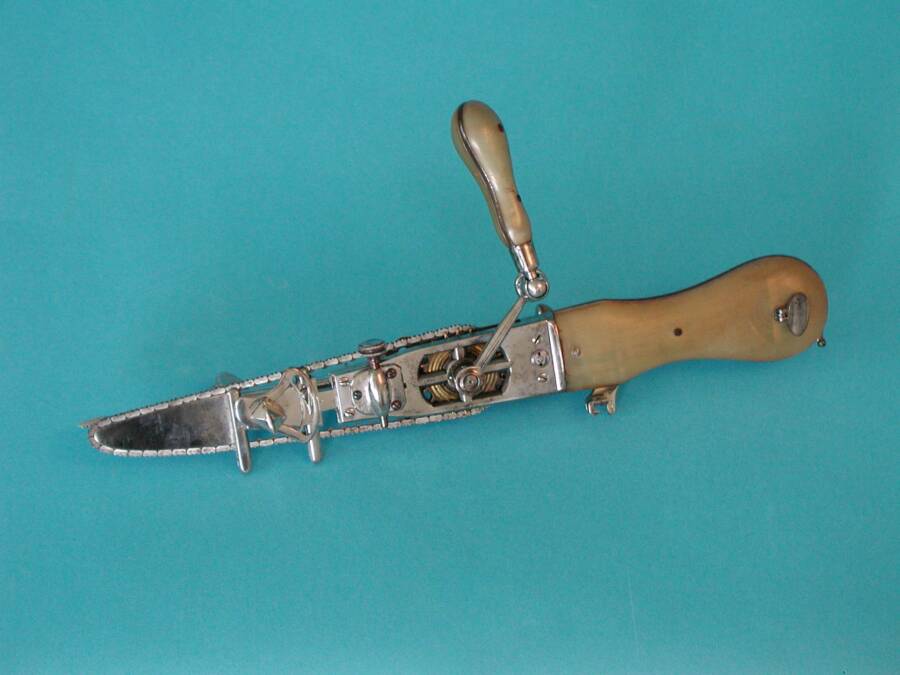Beginning in the late 16th century, physicians assisting mothers with difficult childbirths would slice open a joint in their pelvis to widen it and allow the infant to pass through the birth canal — and the symphysiotomy remained in use in Ireland until the 1980s.

Wikimedia CommonsAn early osteotome, which doctors used to perform a symphysiotomy.
Before it became the horror movie murder weapon of choice, the chainsaw was actually intended to be used in medicine. Specifically, it was created to aid in childbirth. Starting in the 19th century, doctors sometimes used primitive chainsaws to deliver babies in a procedure called symphysiotomy.
The bland-sounding term masks what was, for many women, a traumatizing and debilitating process. A symphysiotomy involved sawing through the cartilage and ligaments of the pelvic joint — and in extreme cases, the bone itself — to allow infants to easily pass through the birth canal.
Though long seen as a safer option than a Cesarean section, symphysiotomies dipped in popularity as medical technology improved and childbirth became safer. But that wasn’t the case in Ireland. There, doctors guided by both medicine and religion continued to rely on symphysiotomies to deliver babies up through the 20th century.
This is the gory history of the excruciating procedure.
A Brief History Of The Symphysiotomy
Childbirth is, of course, as old as mankind itself. But it could be dangerous and often fatal, which is why early doctors invented the symphysiotomy. According to IFLScience, the procedure was first practiced around 1597 and originally involved a doctor manually cutting through a woman’s pubic symphysis joint.
This process was difficult and time-consuming, which is why a Scottish doctor named John Aitken invented a chainsaw-like device to help at the end of the 18th century. (Another doctor, James Jeffray, also invented a medical chainsaw around the same time to excise diseased bone.) According to an article published in the Scottish Medical Journal, Aitken first described the procedure in his Principles of Midwifery or Puerperal Medicine in 1785.

Public DomainA medical tool called an “osteotome” later developed into today’s chainsaws.
In the 19th century, doctors conducted symphysiotomies using chainsaws to help deliver babies when vaginal birth was impossible. Then, Cesarean sections were considered dangerous. Symphysiotomies seemed safer. But as medicine improved, things changed. Doctors began to rely on Cesarean sections, not symphysiotomies, during difficult births.
This was true across the Western world — except in Ireland. There, the procedure remained popular well into the 20th century.
What Symphysiotomies Were Like For Irish Women In The 20th Century
According to The Guardian, symphysiotomies remained a popular surgical option in Ireland even as they were replaced by Cesarean sections elsewhere. This may be because of the Catholic faith of prominent Irish doctors. Multiple Cesarean sections were believed to be so dangerous that future pregnancies would have to be prevented or even aborted, which was unacceptable to many Catholics. However, other physicians have denied that religion played a role.
Whatever the reason, Irish doctors continued to conduct symphysiotomies on their patients until the 1980s. And many of the women who gave birth this way later described the procedure as terrifying, agonizing, and debilitating.
“I just remember being brought into a theatre and the place was packed with people. I wasn’t told what was happening… I was screaming and being restrained,” a patient named Philomena who had a symphysiotomy in 1959 told CNN. “I couldn’t see much except for them sawing. It was excruciating pain. I was just 27 and I was butchered.”
Cora, who was 17 when she gave birth to her first child in 1972, had a similar experience: “I was screaming. It’s not working, [the anesthetic] I said, I can feel everything… I seen him go and take out a proper hacksaw, like a wood saw… a half-circle with a straight blade and a handle,” she remembered.
She continued:
“The blood shot up to the ceiling, up onto his glasses, all over the nurses… Then he goes to the table, and gets something like a solder iron and puts it on me, and stopped the bleeding… They told me to push her out. She must have been out before they burnt me. He put the two bones together, there was a burning pain, I knew I was going to die.”

Niall Carson/PA Images via Getty ImagesMairin O’Moore, center, from the Survivors of Symphysiotomy group presents a petition signed by doctors on behalf of symphysiotomy survivors in Dublin, Ireland. 2013.
Not only was the procedure painful and horrifying, but it also left many women with chronic health issues. Symphysiotomy patients described issues with incontinence, pain, and early arthritis. Some were so traumatized by what had happened to them that they believe it contributed to later miscarriages.
“I feel extreme anger that it wasn’t explained, we weren’t given any options,” Rita McCann, who had a symphysiotomy in 1957, told The Guardian. “No one has taken responsibility. When I met other women it was so hard to listen to their stories – some had lost babies. No one could talk about it without dissolving in tears. I want an apology and an explanation – the explanation should have been done before they ever put a knife into us.”
In 2016, hundreds of Irish women who’d had a symphysiotomy were awarded between €50,000 and €150,000 by the government. By that point, the procedure had all but vanished in the Western world. A study published in the Cochrane Database of Systematic Reviews notes that it’s seen as “second-best” to other options today, though the symphysiotomy is still considered a “life-saving” procedure.
Instead, the device designed for a symphysiotomy has evolved into something else. Today, chainsaws are used to cut down trees — not to deliver children.
How Childbirth Led To Chainsaws
In the 20th century, chainsaws evolved from cutting bone and ligaments to cutting wood. In 1905, American Samuel J. Bens submitted a patent for an electric chainsaw to help fell the “huge redwood timber of the Pacific coast.”
Chainsaws of this caliber, once huge and unwieldy, became lighter and lighter as time progressed. In 1920, German engineer Andreas Stihl came up with the handheld chainsaw, which closely resembles what is still in use today.
As such, the days of using chainsaws for childbirth seem to be behind us. Doctors have better options now, like Cesarean sections, to help mothers and babies get through difficult births. But for the women who survived symphysiotomies, the horrible memory never entirely goes away.
“You blank a lot of it out, over the years,” McCann told The Guardian in 2014, “but you don’t forget. It gave me the horrors.”
After learning about the painful childbirth procedure known as symphysiotomy, read about Robert Liston, the only surgeon to have a 300 percent mortality rate in one surgery. Then, read about how heroin, cocaine, and other now-illegal drugs were once used in medicine.






